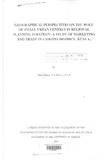| dc.description.abstract | Small urban centers have recently been recognized as important and integral
components of regional planning designs in developing countries. For instance, the
Kenya Government's Development Policy for ASAL (1992: 64), emphasized the
importance of trade and commerce as the main informal sector activity in the
centers of these areas.
This study sought to study a variety of issues pertaining to marketing in the
district in an attempt to find out the potential of growth of small urban centers in the
study areas, and in the adjoining rural (agricultural) economies. The study covered
the major small centers in the district. The issues studied included potential market
areas for some selected centers, distances traveled as applied to preferences of
shoppers for centers, modes of transport used, traffic densities among the major
routes, hierarchy of centers, marketing trends and problems of the farmers.
Both primary and secondary data was collected. Several simple descriptive
statistics were applied in data analysis. Also, cartographic techniques were used to
present and illustrate such data. Inferential statistics were further used to make
general conclusions based on sample results. These included multiple regression and
correlation analysis, simple regression and correlation, and chi-square technique.
G.I.S was also used in data analysis.
The main findings of this work include, the positive correlation between the
attractiveness of a center, on the one hand, and both the total number of customers
visiting a center and the total number of customers present in that center, on the
other hand. Secondly, there was consistency in the modeled zones of influence
compared with the empirical ranking of market potentials of centers.
The relatively small urban centers registered the highest turnovers compared
with the relatively larger centers. Centers which attracted the greatest number of
customers were located further away from the households. The study proved the
existence of inner and outer ranges of a good or service. It also revealed that the
larger the center, the higher the interaction with the hinterland and, hence the higher
the likelihood of diffusion of innovation.
Crops and livestock are marketed predominantly using specific channels. The
most significant consideration by farmers in marketing is prompt payment followed
by transport, good prices, ready market, in that respective manner. Thus, use of
middlemen was the most popular channel of marketing.
In the light of these findings, it is recommended that the Government of
Kenya develops an urban growth strategy that allows both for the possibility of
decline of trade centers as well as the strengthening of the position of growth centers
to be sustained. Also there is need to improve the communication network, and to
provide incentives especially where risks are great for investors to locate in both the
growth and service centers. Finally, a proper creation of the hierarchical structure
of designated growth centers was necessary | en |

